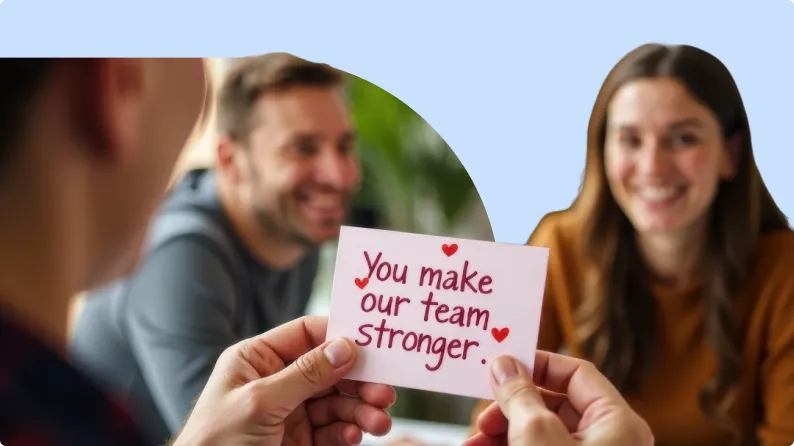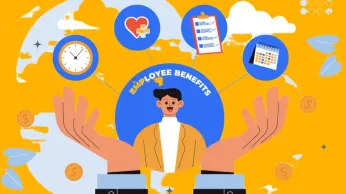On this page
‘Whatever’ was polled as the most annoying word by 34% of Americans in 2019. And the chances that you have said or maybe heard a similar annoying word in your workplace, too.
If it’s true, then you need to prevent the spread of this culture or be prepared to face hardships in the future. The road to employee satisfaction begins where respect at work lies.
Respect isn't appreciated because it's taken for granted at the workplace and is often misunderstood in different contexts. So, let’s understand what respect means first.
Meaning of respect in the workplace
It has several meanings but has no exact definition.
Richard Branson says; “Respect is how to treat anyone, not just those you want to impress."
Employee respect in the workplace must be independent of discrimination, i.e., regardless of age, designation, gender, color, location, etc. Whether the company's CEO or janitor works there, both deserve to be respected.
However, co-workers must not take it for granted. The leaders/workers need to be professional, polite, and respectful to be treated equally.
But does it really matter, you might be asking?
We have drawn a few important points below to illustrate how far a respected workplace can take you and your company.
Importance of respect in the workplace
We don’t notice respect until it’s absent. So, what happens when it’s absent? The workers may feel uncomfortable initially, but if it gets continued, they’ll feel stressed or might leave the company.
It doesn’t end here. The extensive research of 20,000 worldwide employees (conducted by Christine Porath and Tony Schwartz, and HBR) proved that the higher the employer's given respect, the more will be the employee’s engagement.
Here it is.
And why should you care? Because disengaged employees cost U.S. companies up to $550 billion a year, states Forbes. And here’s how a respectful environment can help.
1. Improves job satisfaction
A healthy work environment, where employees’ efforts are addressed, fuels the motivation to perform best. In a survey conducted by the Society for Human Resource Management (SHRM), 72% of employees rated 'respectful treatment' as a top-rated behavior for job satisfaction.
2. Reduces work stress and uplift the workforce
A study, Workplace Stress: Impacts and Outcomes, by Chestnut Global Partners and SHRM, showed that disrespect is the major cause of stress among employees.
One of the major reasons behind the success of the company (mainly staffed by female convicts, 425 out of 650) and Jim Hooker (CEO) was; He valued the imprisoned women (usually perceived as devaluing to society) by giving them an identity of Televerdians.
3. Leads to a knowledgeable environment and company’s growth
Steve Jobs’ success, one of the inspirations to many CEOs, is often credited to his bad behavior with others. However, there’s so much behind the curtains. Edwin Catmull (Pixar’s co-founder), who worked with Steve Jobs for 26 years, says that Jobs’ greatest success came only after he changed from insensitive and impolite to empathetic.
Thus, a leader’s behavior decides workplace health and the company’s growth.
Examples of showing respect in the workplace
People have different perspectives, and incivility to one may be ordinary to another. Therefore, gauging respect at the workplace becomes hard for employers/supervisors and even co-workers.
An unintentional disrespect becomes a habit if not addressed.
Here are examples of respect in the workplace:
- Treat employees with respect regardless of their religion, color, race, gender, location, physical/verbal/mental disabilities, age, or anything that sets them apart.
- Active listening and consideration of others’ suggestions if useful.
- Polite disagreement without demeaning others’ logic in meetings or personal discussions.
- Constructive criticism and appreciation of others’ skills and dedication.
- Acceptance of others' weaknesses and not demeaning them on its basis.
- Handling disputes healthily.
- Unbiased behavior in the workplace when it comes to promotions.
- Encouraging the active participation of team members in meetings/discussions.
- Prohibition of toxic acts such as taunts, harassment, bullying, bitching, name-calling, monopolizing, and belittling others in the workplace.
- Use of formal greetings and polite words such as thanks and please in speech.
Persistence and causes of disrespect
The executive confessed that he became forceful and furious with his co-workers to get things done, as that’s what he saw in his seniors. Hence, resolving the root cause of disrespect is more important than just adopting respectful behavior.
Here are the common causes of disrespect in the workplace:
- Improper functioning of machines or system failure can lead to irritant behavior that becomes a cause of frustration among co-workers and disrespect in the workplace.
- Personal reasons like anxiety, depression, insecurity, aggressiveness, etc., can also trigger outrage.
- Mental disability, substance abuse, or even personality disorder can be the reasons in some cases of disrespect in the workplace.
- Cultural or generational differences are also one of the reasons behind disrespectful behavior.
- Miscommunication between supervisors and employees can also lead to disrespect.
However, the behavior persists because of the following reasons:
- Disrespectful behavior and an unfavorable working environment are like chicken-and-egg. And one leads to the rise of another. ISMP’s 2013 survey concluded that only a quarter of companies deal with disrespectful behavior.
- Managers are likely to shield workers' toxic behavior if they are high-revenue producers. Such incidents lead to the persistence of disrespect in the workplace.
- Also, in some cases, the toxicity persists because the managers are incapable of handling the situation.
How to practice respect in the workplace?
Practicing respect in the workplace boils down to two major steps; prevention and adoption. Let’s learn each of them in detail.
1. Prevention of disrespectful behavior
Here are a few ways to prevent toxicity in the workplace.
-> Shut the disrespectful behavior quickly
As we discussed earlier, disrespect is contagious. It spreads from person to person. Thus, addressing the behavior becomes an immediate necessity. Ignorance will only flourish disrespect and create a toxic work environment.
Moreover, the actions to make such behaviors intolerable indicate the employee’s importance at the workplace.
Facebook is truly committed when it comes to the prevention of disrespectful behavior. Heidi Swartz, the company’s global head of employment law, states that we train employees that if a coworker says “no” to go on a date with you, you don’t ask him/her again. However, “I’m busy” or “I can’t that night” are also considered as clear “no.”
-> Are you the problem?
Your behavior, being a supervisor/team leader or CEO of the company, sets the example to teams and the entire workplace. As the human brain is wired, it is hard to see ourselves committing the mistakes that we find inappropriate in others.
Stanford University Professor Bob Sutton shared a story of a Silicon Valley CEO and how his team made him realize his poor behavior. The CEO used to insult the supervisors in meetings by comparing them to vegetables like you’re dumber than a head of lettuce.
The team paid him back smartly. One day the CEO came to a meeting, and he found lettuce heads instead of his team members at their places. A few heads had eyes, some were smiling, and some had sunglasses.
Even the CEO found a lettuce head at his place. Later, the CEO accepted that he had been hard on his team when it came to the company’s growth and revenue. Also, he became mindful of his words.
-> Conduct surveys & feedback
Conduct surveys and feedback to know whether disrespectful behavior is breathing at your workplace. In 2019, a study by NCBI found that black employees face 60% more discrimination than white people in workplaces. Such incidents lead to stress and job dissatisfaction. The frequent feedback prevents disrespectful behavior and keeps the workplace healthy and in check.
2. Adoption of respectful behavior
Here’s how you can welcome respectful behavior at your workplace.
-> Frame a respectful workplace policy
A respectful workplace policy helps the employees to know the limit of tolerance in the workplace. Also, framing a workplace policy will give them a sense of rework on themselves.
Draw the list of unacceptable behaviors and the guidelines (to avoid the behavior) in the policy to enforce mutual respect in the workplace. You can even outline the inviting penalties if the misbehavior persists.
Assemble the supervisors in discussion to craft the policy. You can even consider employees’ (former or current) feedback and weave them into the company’s processes to improvise. Heather Huhman (founder and president of Come Recommended) says that employee intervention is a sign of a respected workplace policy.
She suggests that an HR policy must be fluid, and the supervisor must revisit the rules to see if they still make sense.Huhman also says that "if everyone wants to have a specific rule (for example, no dating in the workplace), it must be implemented".
-> Appreciate the respectful employees
Appreciation has a profound impact, not only on the individual getting appreciation but also on the people around him.
Co-workers, who witness others getting appreciation, strive to be like others or even better. That’s a huge way to encourage respectful behavior in the workplace as it also excludes the idea of taking respect for granted.
Create a respectful culture with Empuls
Respect is foundational to creating a healthy company culture and productivity, retention, and long-term success.
To connect this with Empuls, here's how the platform directly supports fostering a culture of respect and recognition in the workplace:
1. Detect & prevent disrespect with surveys
Empuls empowers HR and leaders to listen continuously through:
- eNPS and pulse surveys to detect disengagement early.
- Lifecycle surveys (from onboarding to exit) that reveal friction points and areas lacking respect or inclusion.
- 360° feedback and anonymous surveys to identify disrespectful behaviors—especially those that go unreported.
These insights drive targeted, respectful culture initiatives.
2. Promote respect with recognition
Empuls helps build a culture of appreciation through:
- Peer-to-peer recognition for everyday contributions.
- Core values-based awards to reinforce respectful behaviors.
- Smart nudges from Em (AI assistant) that prompt timely appreciation, closing the “recognition gap.”
Automated service awards and milestone celebrations to show long-term respect and gratitude.
Recognition isn’t occasional—it’s continuous and inclusive with Empuls.
3. Facilitate respectful communication
Empuls’ Social Intranet boosts respectful, transparent dialogue via:
- Townhalls with interactive posts, polls, and AMAs.
- Wishboards for birthdays, life events, and service anniversaries.
- Community groups that create psychological safety and foster inclusivity.
With features like emojis, likes, GIFs, and moderation controls, conversations stay fun, kind, and positive.
4. Reinforce positive behavior with rewards
Empuls encourages respectful engagement by:
- Rewarding collaborative behavior, wellness, learning, and team efforts.
- Offering non-monetary and monetary incentives via a rich global catalog: gift cards, experiences, wellness, donations, and more.
Employees who live the values are appreciated publicly and rewarded meaningfully.
5. Manager & HR enablement
Empuls provides:
- AI-powered manager insights to ensure no team member is left unrecognized.
- Automation tools for consistent reward cycles and milestone celebrations.
- Privacy and branding controls to maintain a safe, professional digital workspace.
Let’s outline a Respectful Workplace Policy leveraging Empuls features. This policy will serve two purposes:
-> Set clear expectations for respectful behavior.
-> Use Empuls to reinforce, recognize, and reward that behavior.
Respectful workplace policy (Empuls-enabled)
Following is how you set a respectful culture with Empuls:
1. Purpose
To foster a workplace where every employee feels valued, heard, and safe through respectful, inclusive, and professional behavior. This policy supports our DEI and engagement goals and is operationalized through Empuls.
2. Scope
Applies to all employees, contractors, and interns, across physical and digital workspaces—including Empuls' social feed, community groups, and recognition features
3. Core principles
Treat everyone with dignity—regardless of title, background, or beliefs.
- Communicate openly but with empathy
- Embrace diversity of thought and background.
- Offer feedback constructively and accept it graciously.
- Celebrate each other's wins, milestones, and contributions.
- Use digital platforms (like Empuls) responsibly and respectfully.
4. Behaviors that reflect respect
To be recognized and encouraged via Empuls Rewards & Recognition:
- Active listening and inclusive collaboration
- Timely appreciation of peers (using peer-to-peer recognition)
- Polite disagreement during team discussions
- Inclusion of all voices in meetings (especially underrepresented ones)
- Sharing thoughtful feedback in surveys or community discussions
Reward these behaviors with values-based or spot awards on Empuls.
5. Unacceptable behaviors
To be flagged via surveys, feedback, or community moderation:
- Bullying, taunting, or belittling others
- Discrimination (age, gender, race, etc.)
- Interrupting or ignoring others’ contributions
- Toxic gossip, passive aggression, or sarcasm
- Abusive or unprofessional language in Empuls posts/comments
HR or designated moderators will review flagged content or survey trends.
6. Feedback & enforcement
Use eNPS, pulse, and 360° surveys in Empuls to gather feedback regularly:
- Employees can report disrespect confidentially.
- Empuls admins and HR will take action based on trends and direct feedback.
- Repeat violations will lead to progressive disciplinary action.
7. Recognition & celebration
Promote respect by celebrating:
- Core value champion
- Milestone service anniversaries
- Respectful team players nominated monthly
- Use AI-powered nudges from Em to remind managers to recognize deserving employees.
Display recognitions on Empuls’ Wall of Fame or digital displays across the office.
8. Communications & awareness
Post this policy on the Empuls Social Intranet:
- Use interactive content like polls or quizzes to raise awareness.
- Reinforce during townhalls and community groups.
Schedule a call with Empuls to understand the tailored specifics that you will avail to create a culture of respect.
Conclusion
It is true that when respect is present in the workplace, very few people admire it, and so a very few companies. But its absence can produce such consequences that can lead to a decline in the company’s growth, excellent talent, employee retention rate, and more.
In a nutshell, the company starts sinking. Thus, keep an eye open to identify whether respect is in the workplace and take necessary measures to maintain it.















